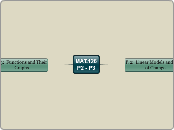af David Kedrowski 15 år siden
406
MAT.126 P.2-P.3

af David Kedrowski 15 år siden
406

Mere som dette
The function y = f(x) is even if f(-x) = f(x) (the graph is symmetric wrt the y-axis)
The function y = f(x) is odd if f(-x) = -f(x) (the graph is symmetric wrt the origin)
Many functions are neither even nor odd.
NOTE: The only function symmetric wrt to the x-axis is f(x) = 0.
Given a function f(x) for which f(a) = 0, we know that the point (a,0) is an x-intercept for the graph of f.
This number a is also known as a zero (or root) of the function f.
Zeros are the solutions to the equation f(x) = 0.
Composite
Quotient
Product
Difference
Sum
Transcendental
Exponential and Logarithmic
Trigonometric
et al.
Tangent
Cosine
Sine
Algebraic
Rational
Radical
Polynomial
Leading Coefficient Test
Even degree polynomials:
If a_n > 0, both ends go to positive infinity
If a_n < 0, both ends go to negative infinity
Odd degree polynomials:
If a_n > 0, the left end goes down and the right end goes up
If a_n < 0, the left end goes up and the right end goes down
Degree
0th degree: f(x) = a (constant)
1st degree: f(x) = ax + b (linear)
2nd degree: f(x) = ax^2 + bx + c (quadratic)
3rd degree: f(x) = ax^3 + bx^2 + cx + d (cubic)
coefficients
leading coefficient
constant term
degree
y = f(x): Original graph
y = f(x-c): Horizontal shift c units to the right
y = f(x+c): Horizontal shift c units to the left
y = f(x) - c: Vertical shift c units down
y = f(x) + c: Vertical shift c units up
y = -f(x): Reflection (about the x-axis)
y = f(-x): Reflection (about the y-axis)
y = -f(-x): Reflection (about the origin)
Identity: f(x) = x
Squaring: f(x) = x^2
Cubing: f(x) = x^3
Square root: f(x) = sqrt(x)
Absolute value: f(x) = |x|
Rational: f(x) = 1/x
Sine: f(x) = sin x
Cosine: f(x) = cos x
A function from X to Y is one-to-one if to each y-value in the range there corresponds exactly one x-value in the domain.
A function from X to Y is onto if its range consists of all of Y.
These you need to determine on your own. Remember that in order for a number to be in the domain of a function, there has to be a real-number image associated with the number.
These are listed with the function. They are common in application problems.
A relation between two sets X and Y is a set of ordered pairs, each of the form (x,y), where x is a member of X and y is a member of Y.
The independent variable is x and the independent variable is y.
The domain of the relation is X and the range of the relation is Y.
A function from X to Y is a relation between X and Y that has the property that any two ordered pairs with the same x-value also have the same y-value.
More formally: Let X and Y be sets of real numbers. A real-valued function f of a real variable x from X to Y is a correspondence that assigns to each number x in X exactly one number y in Y.
The domain of f is the set X. The number y is the image of x under f and is denoted by f(x), which is called the value of f at x. The range of f is a subset of Y and consists of all images of numbers in X.
A function is evaluated by replacing its independent variable with a specific value and then simplifying to find the value of the dependent value.
An explicit equation has been solved for y. An implicit equation has not been solved for y.
m_1 * m_2 = -1
or
m_1 = -1 / m_2
Calculator
m_1 = m_2
y = b
x = a
Ax + By = D
Ax + By + C = 0
y = mx + b
A ratio occurs when both the x and y variables have the same units and the slope therefore has no units (they cancel).
A rate (or rate of change) occurs when the x and y variables have different units.
Typically these rates of change are average rates of change.
In either case, the result tells you the change in y per a 1 unit change in x.
y - y_1 = m(x - x_1)
Slope formula: m = (y_2 - y_1)/(x_2 - x_1)